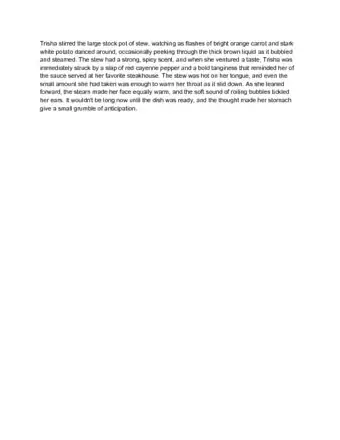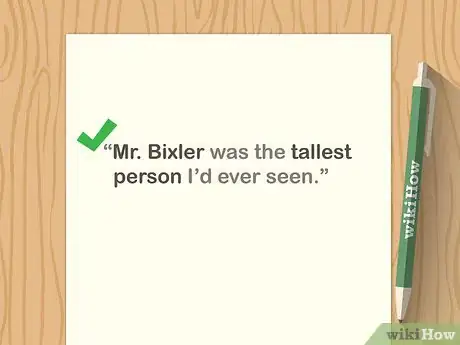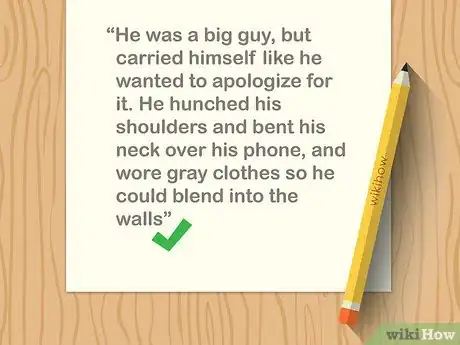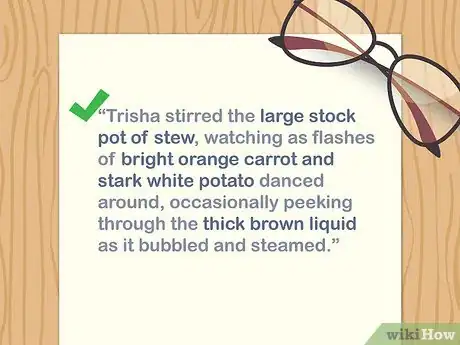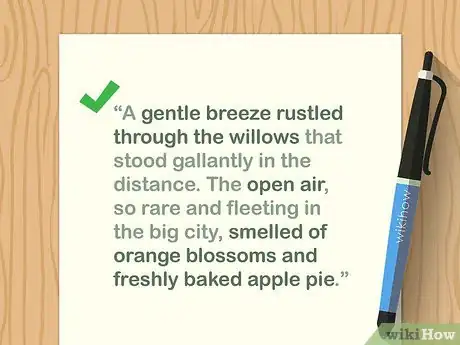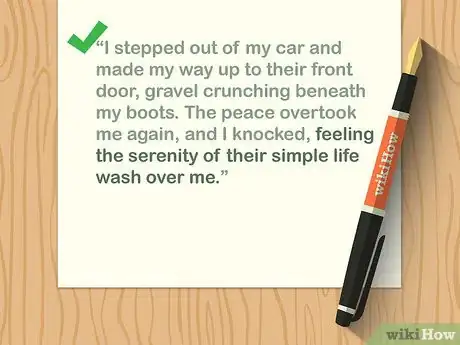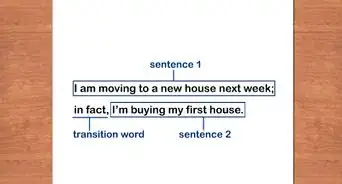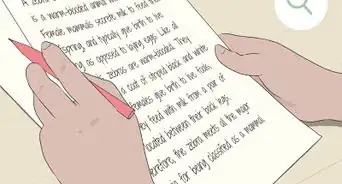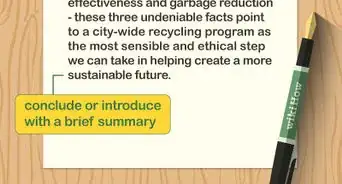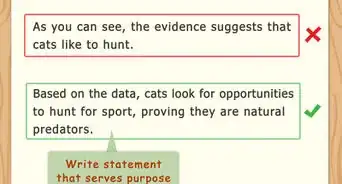This article was co-authored by Christopher Taylor, PhD. Christopher Taylor is an Adjunct Assistant Professor of English at Austin Community College in Texas. He received his PhD in English Literature and Medieval Studies from the University of Texas at Austin in 2014.
There are 7 references cited in this article, which can be found at the bottom of the page.
wikiHow marks an article as reader-approved once it receives enough positive feedback. This article has 31 testimonials from our readers, earning it our reader-approved status.
This article has been viewed 1,748,790 times.
If you want to immerse a reader in an essay or story, there’s no better way to do it than with a crisp, vivid descriptive paragraph. These paragraphs are best when you let your creativity take control, experimenting with structure and content and using unusual, striking phrases to hook your reader’s attention. Whether you’re describing a person, place, or thing, your paragraph should make your reader feel like they’re right there with you or your characters, experiencing the moment firsthand.
Steps
Sample Paragraphs
Describing a Person
-
1Start your paragraph with a general topic sentence that introduces the person. A succinct introduction sentence at the start of your paragraph will help catch the reader’s attention and shift their focus to the person you’re about to describe. Keep this first sentence clear and concise, focusing on one aspect of their appearance so you don’t overwhelm your reader with too much description right away. You can also split your topic sentence into 2 sentences for clarity and flow. Start with something like:[1]
“Mr. Bixler was the tallest person I’d ever seen.”
“Melanie’s hair is the biggest thing about her.”
“To understand John’s thoughts, all you had to do was look at his hands. They never stopped moving.” -
2Focus on the most striking part of their appearance first. To hook your readers in even more, go straight from your general introduction to the most interesting or unusual part of the person’s appearance. Think of this as the thing that you notice first, or that makes the biggest impression on you when you first see it. If you’re writing a more creative piece, like a narrative, you can also use this as your introductory sentence. For example, you could write:[2]
- “I didn’t usually notice people’s skin, but Natasha’s glowed. It was almost alien. Night could be falling, or we could be sitting in a dark classroom, and I’d still see her out of the corner of my eye, faintly golden.”
- “His arms looked too long for his body, and disproportionately muscular, like pale twin boa constrictors.”
Advertisement -
3Focus on physical details that hint at the person’s personality. By carefully choosing your descriptive words, your paragraph can paint a vivid picture of the person while giving the reader a sense of who they really are. Search for strong, resonant words that get across the point you want to make and create a tone that fits with the person.[3]
Showing Personality through Physical Description
Kindness or friendliness: “He had a tendency to slope his back and shoulders to smile right in my eyes.”
Rudeness: “He towered over everyone else in the room, staring over everyone’s heads as though looking for something more interesting.”
Ambition: “She walked with energy that seemed to start in her legs, striding purposefully, and went all the way up through her hair, which swept behind her in a smooth ponytail.”
-
4Fill in any last details to give a good general picture. Make sure that your reader has a good sense for the most important parts of this person’s appearance. You want to at least touch on key aspects of their body and clothing, as well as their face, since these are the parts of the person that the reader will be most interested in. Continue to use strong, descriptive words and challenge yourself to describe them in unique ways.
- To describe a face, for example, you could write, “Her nose and her two front teeth were just slightly crooked. She was constantly pulling her long hair forward and throwing it back again, blinking her bangs out of her eyes like she had no idea how they’d gotten there.”
- To describe someone’s body or clothing, you might write, “He was a big guy, but carried himself like he wanted to apologize for it. He hunched his shoulders and bent his neck over his phone, and wore gray clothes so he could blend into the walls.”
- Even the general details you’re describing should only be mentioned if they add insight into the person or character’s personality or impression. For example, if their eye color doesn’t hint at any deeper part of them, you don’t have to include it.
-
5Use figurative language and strong adjectives throughout your paragraph. Metaphors, similes, and striking, descriptive language will help you paint a picture of the person without losing the reader’s interest. You want to evoke the spirit and appearance of the person without getting too wordy, and strong, well-chosen language and phrases are the best way to do that. Challenge yourself to include a turn of phrase you’ve never heard before, or use a word in a new way to bring out new dimensions of your character or person.
Using Figurative Language
Simile: a comparison between two things using “like” or “as.”
Ex. “Her baby’s ears were as tiny and delicate as seashells.”Metaphor: using a word or phrase with an object, action or person that it can’t literally apply to.
Ex. “In class, Mrs. Sherman was an actress. She flew around the room and boomed out each story we read, using different voices and facial expression for every character.” -
6End the paragraph with a resonant description or conclusion. The end of your paragraph is the part that will stick in your reader’s mind. Try to make your last sentence the most interesting one, either with an unexpected final description or by summarizing the material in a unique, surprising way. You could say, for example:[4]
- “I’d known Lulu for years, but I’d never seen her wear a pair of shoes. In the summer, I’d watch the soles of her feet turn black and callused from the asphalt, which baked so hot under the sun it would let off waves of steam. It had to burn, but she just rose up on her tiptoes and laughed.”
- “In spite of the loud voice, the confident set of his shoulders, and the easy smile, Henry was the saddest person I’d ever met.”
Writing about an Object
-
1Give an idea of the size and general shape of the object. The best way to set up a paragraph describing an object is to immediately give the reader a sense of the object’s position and size. How much space does it take up? Can it fit in the palm of your hand, or does it loom over you? Has it sat so long in one place that it’s gathered dust, or is it constantly in motion? Feel free to split your topic sentence into 2 sentences for clarity and flow. You could write something like:[5]
- “She’d been wearing the necklace for so long, the chain seemed to blend into her skin. It was thin and the jewel was very small, sitting at the exact center beneath the dip in her collarbone.”
- “The water bottle lay on its side in the dirt, just off the main path, so dented that you could barely tell what its original shape had been.”
-
2Describe its sensory details, like color, texture, or taste. Strong sensory details can help your reader relate to an object they’ve never seen before, or cast new light on something familiar. These succinct descriptions, relating to the reader’s sense of touch, smell, taste, or sight, will make the object come alive. Talk about how heavy it is, whether it’s hot or cold, how strong it is, its smell, or even its taste. Get creative![6]
Using Sensory Details
Sight: “The lightbulb was incredibly powerful, throwing off a blaze so bright it was almost violet.”
Sound: “The bag crinkled sharply when I opened it.”
Touch: “The wood of the tree was rough, almost biting, scratching her hand when she brushed against the trunk by accident.”
Taste: “The pizza was garlicky and so salty that he finished his whole glass of soda after just one piece.”
Smell: “When they opened the box, the faded, pungent scent of old paper lifted out.”
-
3Talk about what it’s used for to give a sense of its purpose. How do you use this object—or do you not use it at all? Why, or why not? Showing the reader the object’s purpose through strong, descriptive adjectives can help them visualize it more strongly, or even imagine what it would be like to use it themselves.
- For example, you could say, “It was her lucky pencil, the one she always used for tests, and she kept it in a separate section of her backpack for that reason. She sharpened it slowly with her personal handheld sharpener, then carefully swept the shavings into the trash.”
-
4End by telling or showing how the object is significant, depending on your tone. If you’re asking your reader to read a whole paragraph just about an object, you want them to know why it’s so important. You can do this by telling the reader directly, if your tone is more concise or succinct. For a more subtle option, try showing them its significance by including relevant, telling details about the object or the way someone treats it.
- For example, you could show the importance by writing, “He took his watch off in the bathroom every night, cleaned it gently with a wet tissue, and placed it on a small cloth on his bedside table.”
- For a more direct option, you could write, “The journal had been passed down by her grandmother to her mother and finally to Katie. It was the oldest thing she’d ever owned, and the thing she loved the most.”
Writing a Descriptive Paragraph About a Place
-
1Start by describing the first thing that strikes you about the place. What’s the thing that you notice first when you walk into this house, into this office, or down that street? Is it a certain building, a sign, a window, or even a group of people? Whatever it is that makes this place interesting to you—whether real or made-up—that’s probably the thing that’ll hook your readers, too. Consider focusing on an attribute that you’ll be specifically elaborating on later in the paragraph. Feel free to split your topic sentence into multiple sentences for clarity and flow. Try writing something like:[7]
“It wasn’t just that the buildings were tall—they were, they shot straight from the ground into the clouds and seemed to go for miles—but that they were so clean, almost transparent. It was like the towers stretched up so high that they became more air than steel.”
“The beach was empty, but you could tell it usually wasn’t. There was trash everywhere, abandoned towels, tipped over coolers, even a whole umbrella, unfurled, sticking out of a hole in the ground.”
-
2Highlight small place details to make your description interesting. Almost everyone has seen a bedroom before, or gone into a classroom or a grocery store. Focusing on specific aspects that make the room, classroom, or grocery store unique and different is what will hook your readers and help them visualize this place. You could say, for example:[8]
- “The river ran so high along its banks that it sloshed over the sides of the walls, spilling brown water into the streets, but no one seemed to view this with alarm. I watched a man ride his bike just along the wall, speeding straight through the biggest puddles.”
- “The neighborhood was perfectly suburban, but sat right across the two-lane road from miles of sprawling cornfields, green arms sifting through the breeze, punctured here and there by broken-down farm houses.”
-
3Use surprising, exotic language to make the place come to life. Even the most seemingly boring of locations can become vivid and fascinating when paired with strong language. Look for words that capture the spirit of the place, whether it’s a strange old house or a teenage boy’s bedroom. Try descriptive words you normally wouldn’t use and see how they work in your paragraph—you might be surprised by the results.[9]
- For example, in The Handmaid’s Tale, Margaret Atwood describes a room as “A chair, a table, a lamp. Above, on the white ceiling, a relief ornament in the shape of a wreath and in the centre of it a blank space, plastered over, like the place in a face where the eye has been taken out.”
-
4Add sensory details to appeal to your sense of scent, touch, and sound. Make your readers feel exactly what it’s like to be in this place, from the wind on their face to the sound of dogs barking or cars rushing past. Can they smell anything? What are they looking at? What do they hear?[10]
- For example, you could write, “He couldn’t remember the last time the house had been quiet. Someone was always flying up or down the stairs in heavy, clomping boots, peeling open the refrigerator door, blaring a baseball game on the radio or yelling to turn it off again.”
-
5Write about how you or your character react to the place. Huge chunks of place description can get a little boring for even the most dedicated reader. To keep their attention, add a little action into the mix. Placing a person in your location, even if it’s just a general “you,” can invite the reader to step into their shoes and actually interact with the place, and can also create an interesting, unique tone. For example, you could write something like:[11]
- “Standing there at the foot of the Rockies, seeing mountains for the first time, it was like the whole world was shrinking, especially me. It made me dizzy, how small I had become.”
- “The rain slammed down around them, standing at the bus stop in a dim yellow circle of light. She tugged her coat closer, feeling the chill in her fingers and watched him try to talk over the sound of the water.”
-
6Include only the most important details so you don’t bog your reader down. Keep your place description paragraph to 3-4 sentences of just the most important aspects. Don’t overload your reader with things they don’t need to know! Include only the details that give them the sharpest picture of the place, contribute to the tone of your overall piece, or end up being important later in your story or essay.[12]
Community Q&A
-
QuestionHow can I write about my country?
 Community AnswerWrite about the things you love about your country or something that you find interesting about your country. Include the things that set your country apart from the rest of the world.
Community AnswerWrite about the things you love about your country or something that you find interesting about your country. Include the things that set your country apart from the rest of the world. -
QuestionHow do I describe a person in a descriptive paragraph?
 Community AnswerUse adjectives to describe physical appearance, personality, or what the person means to you.
Community AnswerUse adjectives to describe physical appearance, personality, or what the person means to you. -
QuestionHow can I describe a room?
 Bun bunTop AnswererDescribe the items in the room in detail and think of what sounds or aromas surround you. If it's a kitchen, describe smells such as bread or overcooked turkey.
Bun bunTop AnswererDescribe the items in the room in detail and think of what sounds or aromas surround you. If it's a kitchen, describe smells such as bread or overcooked turkey.
References
- ↑ http://www.uni-koeln.de/owc/descperson.htm
- ↑ http://www.uni-koeln.de/owc/descperson.htm
- ↑ https://www.bbc.co.uk/bitesize/guides/zx499j6/revision/4
- ↑ http://www.uni-koeln.de/owc/descperson.htm
- ↑ https://vln.school.nz/groupcms/view/845349/descriptive-writing
- ↑ https://www.iup.edu/writingcenter/writing-resources/organization-and-structure/descriptive-writing.html
- ↑ https://www.bbc.co.uk/bitesize/guides/zx499j6/revision/3
- ↑ https://www.bbc.co.uk/bitesize/guides/zx499j6/revision/3
- ↑ https://owl.purdue.edu/owl/general_writing/academic_writing/essay_writing/descriptive_essays.html
About This Article
To write a descriptive paragraph, start by introducing the person, place, or thing you want to describe in the first sentence so you grab the reader's attention. Use striking phrases and vivid adjectives to help the reader visualize everything. Try to be as specific as possible by describing the way things smell, taste, feel, and sound. You can also include some metaphors or similes to help the reader fully experience what you're describing! For tips on writing an effective final sentence for your paragraph, read on!

